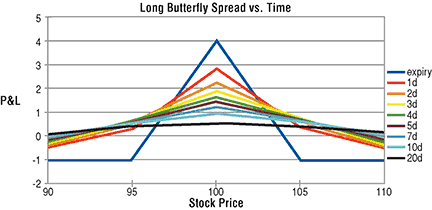OPTIONS
Capturing Trend Transitions
Iron Butterfly And Condor Slices
This option strategy may be effective when the market is transitioning from trending to trendless.
Markets, market sectors, and individual stocks can cycle between states of price balance and imbalance. An underlying market, market sector, or stock is in a state of price balance when there is equilibrium between buyers, sellers, and the underlying market moves in a trendless or sideways fashion. A market is in a state of price imbalance when buyers overwhelm sellers and prices trend higher, or sellers overwhelm buyers and prices trend lower. An imbalanced (trending) market will eventually reach a price where sufficient buying or selling is attracted to correct the imbalance and the market will begin to move in a trendless fashion until the next event pushes it into imbalance, and the process starts over.
Capturing and profiting from the transition from a trending market to a trendless market is a tricky business. Expressions such as “the trend is your friend,” “never try to pick the top,” and “never catch a falling knife” can be found in most trading literature (and overheard in the bars near the exchanges). However, these common expressions tend to apply more to trading the underlying stocks or futures than options on those stocks or futures.
The unique properties of options, including option spreads may allow traders to violate some traditional rules of trading without leaving themselves exposed to the unlimited risk of a naked position in underlying contracts. By combining options into spread strategies, traders can take positions that can fit the complex scenarios that occur when markets enter a transitional or pretransitional phase. One such structure that may be effective for entering a market that appears to be transitioning from trending to trendless is the long “iron” butterfly or condor.
Profiting From A Directionless Market
So what type of option strategies will potentially profit from a trendless market? If a market is trendless, hovering around the same prices every day or floundering inside a trading range, the only thing really changing on a day-to-day basis is the passage of time. So it follows that those option strategies that are neutral in terms of direction, but benefiting from the passage of time — strategies with positive time decay — may be ways to address a directionless market.

FIGURE 1: long butterfly value vs. time to expiration.
Time Decay
The price of an option has two component values, intrinsic and extrinsic. Intrinsic value is the amount by which an option is in-the money. A call option is in the money if the price of the underlying is above the strike price. A put option is in the money if the price of the underlying is below the strike price.